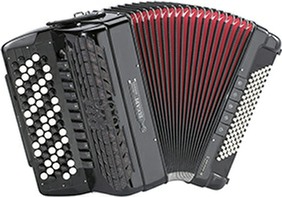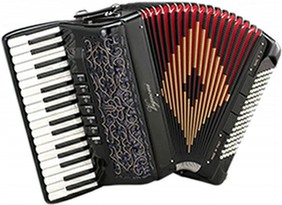There are two distinct styles of accordion - piano key and chromatic button key. Both are suited to playing all genres of music.
Piano Accordion
Piano accordions are the best known and most popular type of accordion in the western world.
The treble keyboard has piano keys with a range of between two and four octaves.
For beginners, the familiarity of the keyboard means that the piano accordion is often the easiest to start with.
All types of music can be played on piano accordions. Lightweight, compact piano accordions are particularly suited to traditional styles of music. A full size 120 bass piano accordion offers the greatest flexibility, especially if you wish to play classical repertoire.
Chromatic Button Accordion
Chromatic button accordions are common in Eastern Europe and Russia, where they are known as “Bayans”.
The treble keyboard has up to 5 rows of buttons arranged in a diagonal chromatic pattern. To aid fingering, rows 4 and 5 (nearest the treble grille) repeat same notes as rows 1 and 2.
There are two systems (button layouts) - B and C which mirror one another. The choice of system is one of personal preference often influenced by which layout you find most comfortable and the system your tutor advocates.
Button accordions are compact and offer a greater range of notes compared to their piano counterparts. As the buttons are positioned close together, large leaps and stretches are easier. Chromatic accordions are therefore ideal for demanding classical pieces.


96 Bass Chromatic Button Accordion


Types of Accordion


Accordions produce sound by blowing air generated by the bellows across its reeds.
Each bank or set of reeds is called a “voice” - an accordion can have up to 5 “voices” (5 sets of treble reeds).
The pitch of each voice is described in feet, the same as organ pipes, and there are 3 standard types:-
4’ Sounds 1 octave higher than the note played (“piccolo” reed)
8’ Sounds at the pitch of the note played (“clarinet” reed)
16’ Sounds 1 octave lower than the note played (“bassoon” reed)
There can be multiple voices at any of the three pitches - it is normal for there to be two, sometimes three 8’ voices.
The reeds or voices can be played singly or in various pre-fixed combinations which alter the tone and sound of the accordion. Each combination of reeds or sound is called a “register”. Registers are selected using switches or “couplers” which link the voices together.
The number of buttons on the bass keyboard describes the size of an accordion. Sizes range from 8 up to 120 bass. As the number of bass buttons increases, so does the flexibility of the accordion because repertoire becomes less restricted because there are more notes.
48 bass accordions are often considered a good beginners size, particularly for younger students since they are very compact, lightweight and easy to handle.
72 bass is a good mid-range size. Ideal for adult beginners, they are lightweight and compact although, may restrict your repertoire.
96 bass accordions offer many of the features of a fully specified 120 bass instrument but in relatively lightweight and compact size. They offer great scope and flexibility.
120 bass full size accordions are the most flexible offering features that are not commonly found on smaller instruments.
Bass Systems
There are two bass systems, either or both of which can be paired with a piano or button treble keyboard.
Stradella Bass
The most widespread and popular, Stradella bass is an ingenious system which allows you to play all styles of accompaniments, complex chords and melodies.
Comprised of up to 6 rows of buttons, the 2 rows nearest the bellows play single notes over a range of 12 semitones, the remaining rows producing fixed chords (major, minor, seventh and diminished).
Despite its clever design, melodies may not always sound at true pitch because of the limited range of single notes.
The layout is the same on all sizes of accordion.
Free Bass
A system of singles notes arranged in a diagonal chromatic pattern. Having a range of several octaves, it allows melodies to be played on the bass at true pitch. For this reason it is sometimes referred to as the “classical” bass system.
Like chromatic button treble keyboards, there are several different layouts available.
Convertor Bass
Combines Stradella and Free Bass systems into one allowing you to have both systems in one accordion!
Pressing a switch “converts” the Stradella bass chord buttons into the single notes of the Free Bass system.
There are two fundamental styles of accordion tuning:-
Musette (“Wet Tuning”)
Musette tuning uses 2 or more sets of 8’ reeds tuned off pitch from each other to produce a vibrato effect. The further apart the reeds are tuned, the stronger the vibrato or “wetness”.
3 sets of 8’ reeds are used in traditional musette tuning - one on pitch, one tuned slightly above, the other slightly below. Modern musette accordions sometimes use only 2 sets of reeds tuned apart to save weight.
Double Octave (“Straight Tuning”)
Using 4’ (piccolo) and 16’ reeds gives a 2 octave spread so creating Double Octave tuning. The voicing also includes 8’ on pitch reeds.
Double Octave accordions are characterised by a “dry”, organ like tone.
Cassotto
To achieve a softer, more mellow sound, reeds can be built into a Cassotto tone chamber. Reed sets normally placed “in cassotto” are 8’ (on pitch) and 16’.
Double Cassotto describes an accordion with 2 sets of reeds placed in the tone chamber and Cassotto, (or Single Cassotto) an accordion with 1 set.
Each type of accordion has advantages over the other and your choice is really one of personal preference. Two fundamental considerations that may influence your decision are:-
- Your preferred style of music - traditional, classical or a mix of genres.
- If you wish to take lessons, does your tutor teach the type of accordion you want to play?
To further help you decide which accordion is right for you, below is a summary of the pro’s and con’s of piano and button instruments:-
Which Type of Accordion is Right for Me?
Piano Accordion
• Familiar keyboard layout - easier and more intuitive for beginners to learn than the button keyboard.
• Broad selection of tutor books and other learning material readily available.
• Large range of instruments available in a variety of sizes, tunings, colours and finishes.
• Better supported in Western Europe with more qualified teachers available than for button accordions.
• Cheaper to buy than button accordions

• Physical Size - a piano accordion of any given bass size is generally larger than its button equivalent.
• Fewer treble notes than button accordions.
• Large leaps and stretches harder to achieve than on a button accordion where the notes are closer together.

Chromatic Button Accordion
• Smaller and more compact than a comparable piano accordion.
• Larger range of treble notes than on a piano accordion - a necessity if you wish to study classical music.
• Buttons (notes) placed closer together, making large leaps and stretches easier to play than on a piano accordion.
• Easier fingering of complex passages by virtue of the duplicated notes on a 5 row keyboard.

• Unfamiliar keyboard layout - less intuitive and more challenging for beginners than a piano keyboard.
• Limited selection of tutor books.
• Smaller range of instruments available compared to piano accordions.
• Less popular in Western Europe than piano accordions - fewer qualified teachers available.
• More expensive to buy than piano accordions and limited resale opportunities due to lower demand.



Home > Types of Accordion
The ACCORDION LOUNGE Much Wenlock Shropshire UK | © The Accordion Lounge 2016 - 2026 All Rights Reserved




07533 930603
accordionlounge@outlook.com
OPENING TIMES
Tuesday to Saturday: 10:00am to 4pm
Sunday & Monday: By arrangement
Please note that visits are by appointment




















